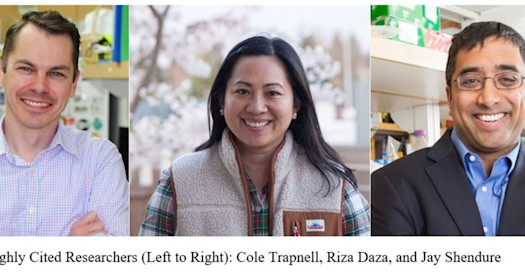Shawn Fayer was in a coffee shop in Boston in 2017 when he read those words in the commentary, “Variant Interpretation: Functional Assays to the Rescue,” published in The American Journal of Human Genetics. The authors of that commentary include several members of the Brotman Baty Institute, including Drs. Jay Shendure, Georg Seelig, and Maitreya J. Dunham. The paper was led by BBI Drs. Lea Starita and Doug Fowler.
“I thought, ‘This is it. This is what we should be doing.’” Fayer said recently. The commentary, he said, “lit a fire under me.”
That fire led to Fayer to leaving his position at Brigham and Women’s Hospital and joining the UW Medicine Department of Genome Sciences as a Ph.D. student. And in December of 2021, he was the first author on a paper that validates a prediction in the commentary: that multiplexed functional data would “move the needle” on clinical variant interpretation. The paper, “Closing the gap: Systematic integration of multiplexed functional data resolves variants of uncertain significance in BRCA1, TP53, and PTEN,” was also published in The American Journal of Human Genetics; Starita and Fowler are co-corresponding authors.
“This paper underscores the need for greater collaboration between the research and clinical communities,” Fowler said. “Our ultimate goal is to examine most, if not all, genetic variants, so our learnings and insights can inform patient care.”
Fayer said the paper does, indeed, contribute to “closing the gap” between variants of uncertain significance and variants whose significance or relevance for clinical application are identified or resolved. The paper notes that “multiplexed assays of variant effect (MAVEs), where thousands of single-nucleotide variant effects are simultaneously measured experimentally, provide functional evidence that can help resolve variants of unknown significance. However, a rigorous assessment of the clinical value of multiplexed functional data for variant interpretation is lacking.”
While conclusive evidence of variants’ clinical meaning remains elusive, the paper uses those MAVES strategically to create “framework in a stringent clinical fashion” to resolve VUSs. The researchers combined previously published BRCA1, TP53, and PTEN multiplexed functional data with phenotype and family history data for 324 VUSs acquired from Ambry Genetics, a California-based company that seeks to interpret scientific research into clinically actionable test results.
Fayer believes the results were impressive.
“The multiplexed functional data were effective in driving variant reclassification when combined with clinical data,” he said. “We eliminated 49 percent of VUSs for BRCA1, 69 percent for TP53, and 15 percent for PTEN. As a result, this data, which are being generated for numerous genes, are poised to have a major impact on clinical variant interpretation.”
The paper concludes with a recommendation and a hopeful forecast for the future: “Data generators and clinicians should work together to design, pilot, and validate MAVEs as well as to integrate the resulting functional data into interpretation workflows in order to maximize the potential of these powerful data. Ultimately, a confluence of high-quality multiplexed functional datasets, large numbers of control variants, and reassessment of interpretation guidelines could transform our ability to definitively interpret VUSs.”
Elaborating on that forecast, Fayer hopes he and his BBI colleagues will determine ways to modify the assays used for studying the BRCA1, TP53, and PTEN genes and apply them to stem cells to examine other medically actionable genetic conditions. Additionally, integrating data with biobanks may have even greater impact in reclassifying VUSs from clinical genetic testing.
“We want to build on the progress of this study and ‘close the gap’ even further,” Fayer said. “The more our efforts can resolve these variants of unknown significance, the more we as scientists can provide clinicians the tools they need to mitigate, and even prevent certain diseases in their patients.


